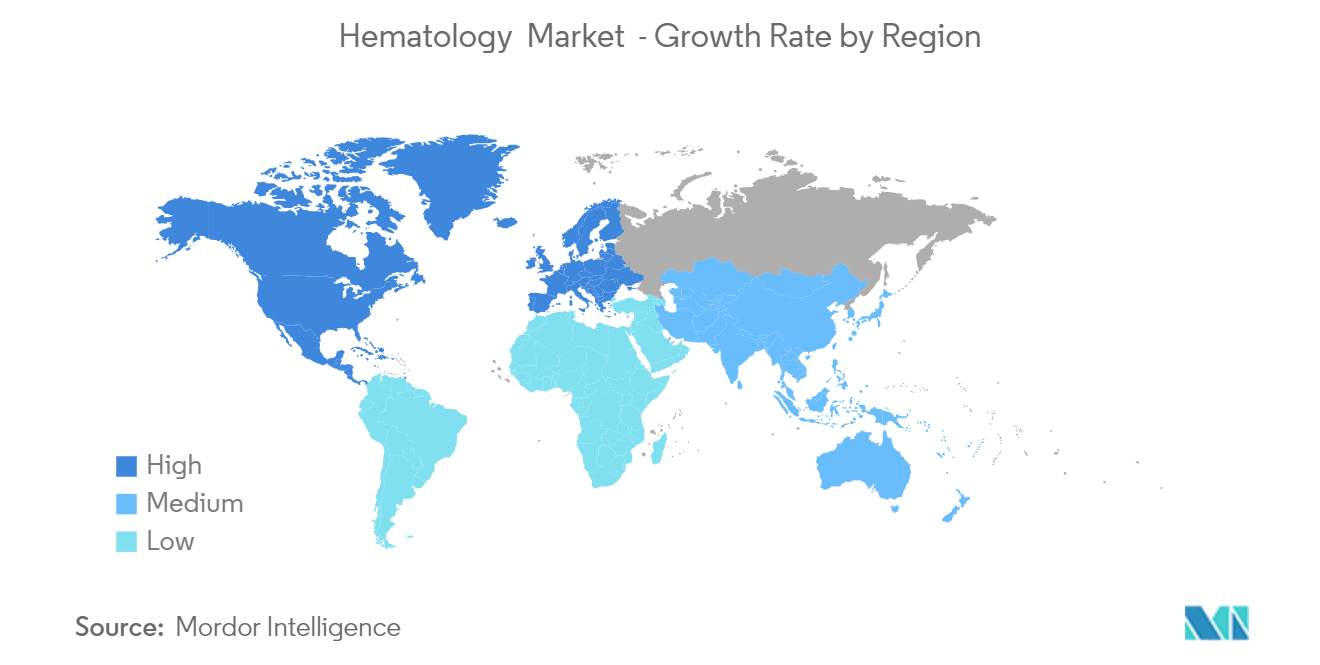Market Trends of Global Hematology Industry
The Hematology Analyzers Segment is Expected to Register Significant Growth During the Forecast Period
Hematology analyzers are instruments used to run tests based on blood samples. They are used to perform tests such as complete blood count, including red blood cell, white blood cell, platelet, and hemoglobin count, and characterizing the blood cells to diagnose a disease condition. The growing burden of blood-related disorders and advancements in technology for developing hematology analyzers with advanced features are the major drivers for the growth of the segment.
Blood disorders, such as anemia, blood cancers, hemorrhagic conditions, and infections in the blood, affect millions of people each year across all age groups. This rising incidence of blood disorders is projected to drive the adoption of hematology analyzers and is expected to accelerate market expansion. For instance, according to May 2023 data from the World Health Organization (WHO), anemia is one of the serious public health conditions, and it is estimated to affect around 40% of children 6-59 months of age and around 37% of pregnant women around the globe.
This higher burden of anemia is likely to create demand for hematology analyzers to count key components of blood, and reduced blood count highlights the burden of anemia. Thus, the growing incidence of anemia is likely to accelerate segment expansion during the study period.
In addition, the growing technological advancements in hematological analyzers and the availability of new-generation hematology analyzers are further anticipated to fuel the segment uptake during the forecast period. For instance, according to an article published in the Journal of Laboratory And Precision Medicine in January 2024, technological advancements in hematology analyzers can provide information beyond the simple counting and differentiation of blood cells. Such capabilities of advanced hematology analyzers facilitated their adoption across end users, which is expected to accelerate segment market uptake during the study period.
Also, product launches and several other initiatives by market players are projected to accelerate segment growth during the study period. For instance, in June 2024, HORIBA expanded its acclaimed compact hematology instrument range by launching new models with erythrocyte sedimentation rate (ESR) capabilities. The Yumizen H550E (autoloader), H500E CT (closed tube), and Yumizen H500E OT (open tube) provided combined testing for CBC/DIFF along with ESR results from whole blood within 60 seconds, enhancing the instruments’ functionality for inflammatory disease assessment.
In addition, in July 2022, CellaVision launched DIFF-Line. CellaVision DC-1 is a single-slide analyzer that automates and digitizes the process of analyzing peripheral blood smears. Thus, product launches are expected to increase market growth during the forecast period.
Hence, due to the abovementioned factors, such as increasing technological advancements in hematology analyzers and increasing product launches by market players, are expected to fuel segment uptake during the study period.

North America Holds the Largest Market Share, and It is Expected to Follow the Same Trend During the Forecast Period
North America is expected to exhibit a significant growth rate in the overall hematology market during the study period. The higher market growth is mainly driven by factors such as the growing burden of hematological disorders, technological advancements in hematological instruments, and high usage of hematology instruments in hospitals and diagnostic laboratories. In addition, key market players' various organic and inorganic business strategies are projected to hinder market growth during the forecast period.
The increasing burden of hematological conditions across North America is projected to support market uptake. For instance, according to 2024 data from the American Cancer Society, myeloma cases increased from 35,730 in 2023 to 35,780 in 2024. In addition, according to the Canadian Cancer Society, the incidence of leukemia is expected to rise from 6,400 in 2023 to 6,600 in 2024. Such an anticipated rise in blood disorders is likely to fuel the uptake for new generation hematology analyzers, which is projected to bolster market growth during the forecast period.
The region has one of the most developed healthcare infrastructures. Hence, companies often form strategic alliances and agreements with other companies to bolster the distribution of their hematology products across the United States. For instance, in April 2024, PixCell Medical signed a strategic distribution partnership with Medline following its recent agreements with Henry Schein and Thermo Fisher Scientific. These partnerships represented a significant milestone in PixCell Medical's expansion strategy. The company aimed to enhance accessibility to its flagship product, the HemoScreen point-of-care complete blood count (CBC) analyzer, throughout the United States.
Such strategies undertaken by market participants are expected to bolster their business avenues in new geographies, ultimately facilitating market expansion during the forecast period.
Various business activities undertaken by market participants to strengthen their position are expected to drive market growth during the forecast period. For instance, in February 2023, Cytec Biosciences signed an agreement with DiaSorin to acquire its imaging and flow cytometry business. This acquisition is expected to bolster Cytec Bioscience's flow cytometry business in the United States. Thus, such efforts by market participants are anticipated to accelerate market growth during the study period.
Therefore, the abovementioned factors, such as technological advancements in hematological instruments, high disease burden, and several strategic initiatives undertaken by market participants, are expected to boost market growth over the coming years.


